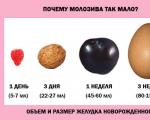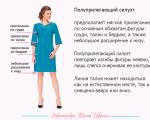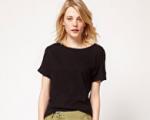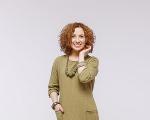Application for children “Autumn canning. Summer applique "Fruits" made of paper for older children in kindergarten
Let's cook lunch. We will cook soup and compote.
Did you know that you can make soup from vegetables, and sweet compote is made from fruits and berries.
What do we need:
2 album sheet;
Vegetables and fruits, drawn and cut out, or can be cut out of colored paper;
Pencils;
Glue. If you color vegetables and fruits watercolor paints, then it is better to glue it with a glue stick. If PVA gets on the watercolor, the paint may smudge a little and it won’t turn out very aesthetically pleasing.
For kids, make all the preparations in advance. Older children can be involved in carving; they really love this activity.
Take 2 album sheets. On each of them we will draw a large pan (outline). We label one pan “Soup”, the second - “Compote”. We decided to not only label our drawn pots, but also color them different colors. I deliberately left the center of the pans white so that the vegetables would not get lost against the colored background. In our pink pan we will cook compote, in our blue pan we will cook soup (let the child choose).


Before preparing dinner, you can play a little with cut-out vegetables, fruits and berries, “feed” different toy animals, and find out who likes to eat what. For example, a bunny loves carrots and cabbage, a goat won’t refuse cabbage either, and a bear simply loves raspberries!
Now we need to determine what we will put in the soup, and what we will “cook” the compote from. Explain that you can make a delicious soup or salad from vegetables, and from sweet berries and fruits you can make a wonderful sweet compote.
First, place the fruits and vegetables in the desired pans, and then glue them.
You can do it wonderful applique, to which you can periodically return and remember where the vegetables are, where the fruits and berries are.


Educational.
Reinforce the concept of “fruit”.
Fix the name of the colors: red, yellow, blue, green.
Develop skills in carefully gluing ready-made forms.
Developmental.
Develop the ability to answer the teacher’s questions.
Develop attention, thinking, memory.
Educational.
To cultivate moral qualities: kindness, responsiveness, desire to help others during a joint discussion, independence in completing a task.
Integration of educational areas: “Cognition (formation complete picture world), “Labor”, “Artistic creativity” (application) , “Communication”, “Socialization”.
Materials and equipment: multimedia installation, basket with fruits (2-3 pieces of each fruit), slides with an image of an orchard, tray, apples, pears, plums, real and cut out of colored paper; sheets of white paper cut into the shape of a jar; glue, brushes, napkins.
Preliminary work with children:
Looking at illustrations of fruits and fruit trees.
D/i “What grows where”, “Wonderful bag”.
Progress of children's direct educational activities:
Children enter the hall and sit on chairs. Grandmother (a teacher dressed as a grandmother) comes in with a basket (apples, pears, plums) and says hello.
Grandma: Hello, guys. I am grandmother Varvara. I have a garden. Various things grow in it fruit trees, look and name what trees you know. (On the screen is a slide with an image of an apple tree). What is this, guys? (Children's answers). Or maybe it's a Christmas tree? No, this is an apple tree, apples grow on it, and this is a Christmas tree, cones have grown on it (there is a spruce with cones on the slide). I also have (slide with pears) growing – what is it? That's right, this is a pear, there are ripe and delicious pears on it! Also in my garden is there a (plum slide) plum tree? There are a lot of delicious juicy...(plums) on it.
Grandmother: There are different fruit trees (apple trees, pears, and plums) in the garden. I brought fruit from these trees. (Takes out an apple). What's this? (children's answers) What is it like? (Juicy, ripe, red). Now feel how the apple smells. (Gives an apple to 2-3 children.) What does an apple smell like? (tasty, pleasant). I suggest you look at what the apple has inside. I'll cut the apple in half with a knife, look what you see? (cuts the apple in half and examines the seeds, they are small, brown, there are a lot of them). Want to try what an apple tastes like? (Treats the children with a pre-cooked apple, pieces on a skewer on a plate for each child), offers to eat a slice. While the children are eating, the teacher lists the signs: hard, crunches on the teeth (you can invite the children to close their eyes and listen to the crunch), sweet and sour, juicy, very tasty. Then pears and plums are examined in the same way. What pear? (The pear is soft, juicy, sweet, it also has small brown seeds, there are a lot of them). And I also have... in my basket. Plum. What plum? (small, round, blue). What does a plum have inside? (cut with a knife) And the plum has one large pit. Let's taste the plum. The plum is soft, sweet, and does not crunch.
Guys, look here, what do you see on the screen? (apples, pears, fruits). What can you make from fruits? (jam, compote). What do you need to do first for this, look, guys? (wash, then cut, then cook). And that's what happened! (compote, jam).
Guys, let's play a game “Which fruits are the fastest.” I suggest boys become apples and girls become pears. To do this, take pictures (apples and pears cut out of colored paper) and stick them on your clothes. (Children stick, teacher helps). Look, there are hoops on the floor, red and green. When the music starts, apples and pears will scatter throughout the hall; as soon as the music stops, the apples will gather in a red hoop, and the pears - in a green hoop. (The game is repeated twice, the hoops are swapped). Now, guys, let's exercise our fingers and play a game “We’re making compote.”
Finger gymnastics “Cooking compote”
(children imitate actions according to the text).
We will cook compote
You need a lot of fruit, that's it.
Let's chop apples
We will chop the pear.
Let's squeeze it out lemon juice,
We'll put in some drainage and sand.
We cook, we cook compote,
Let's treat honest people
We played so well, now come to the tables.
Application “Canning fruits”.
Grandmother: I suggest you prepare fruit in jars for the winter (show the jar where we will stick the fruit). To do this, we will take apples, pears, plums cut out of colored paper, spread them with glue with reverse side and stick it on the jar and press it with a napkin. Whatever sticks well. Now guys, stick the fruits on your jars. (Shows how to coat the parts with glue and glue them onto a sheet.) Children repeat the teacher’s actions, performing the appliqué (reminds them of accuracy). The teacher praises the children's work. Well done guys, you did so well. Let's collect your jars of compote and jam and show them to moms and dads.
Reflection.
What did we do today?
What did we look at and taste?
What game did you play?
How did you “prepare” fruit for the winter? (Well done boys)
Grandmother: I didn’t come to you empty-handed, I brought a treat (takes out a jar of apple compote from the basket). I suggest trying it in a group.
This summary was developed for children of the middle group, in accordance with educational program“From birth to school”, edited by M. A. Vasilyeva. The presented summary is the author's development of teacher S.N. Monakhova.
Relevance of the abstract. In children of middle age preschool age It is often difficult to classify objects. Children confuse generalizing words: “vegetables”, “fruits” with the names of the objects themselves. To eliminate these difficulties, this summary was developed.
Lesson objectives.
Learn to classify fruits and vegetables. Teach children to make an applique, apply glue to the entire surface of the part and carefully stick it onto the sheet.
Preliminary work: looking at illustrations and models of fruits and vegetables, talking about where fruits and vegetables grow, about their use, watching presentations on this topic, reading fiction.
Materials:
A Luntik toy, a truck, dummies and pictures of fruits and vegetables, a poster “What Grows Where,” 2 large and small saucepans, two 3-liter jars with lids (red, green), a bag.
For application: half a sheet of white paper in the shape of a jar, with a glued strip (lid) of colored paper, colored silhouettes of fruits, glue, a brush, oilcloth, a rag or napkins for each child.
Progress of the lesson
Luntik arrives on a large truck, in the back, in magic bag there are fruits and vegetables. The teacher draws the children's attention to the guest, drives the car in a circle several times and stops it in the center of the group.
Luntik greets the guys.
Playback - Hello, Luntik! What do you have in the back? (Looks into the back and takes out a bag) How heavy?
Luntik - My favorite vegetables and fruits are there.
Playback - Guys, let's take a look.
Each child takes turns taking one item out of the bag, showing it to the other children, and naming it. We all find out together what a fruit or vegetable it is, what color it is, where it grows, what can be cooked. (look at the poster “What Grows Where”).
Playback - Verochka, please come and put your hand in the bag. What's in there? Take it out, turn to the guys, show it and name the object.
(this is cabbage). What colour? (green). Where does it grow? (in the garden). What can you cook? (borscht, cabbage soup, salad). You are right, well done. If the child cannot cope with the task, the children help in chorus, and he repeats after them.
Playback People learned to cook food from vegetables and fruits, and they also came up with riddles about them. Try to guess.
No windows, no doors
The room is full of people. (cucumber)
The red nose has grown into the ground. (carrot)
Balls hang on the branches,
Turned blue from the heat. (plum)
A hundred clothes and all without fasteners. (cabbage)
There is grass above the ground,
Burgundy head underground. (beet)
Grandfather is sitting, dressed in a hundred fur coats,
Whoever undresses him sheds tears. (bow)
Round, rosy,
I'm growing on a branch
Adults love me
And little children. (apple)
(I show a picture for each answer)
If the children don’t know the answer, Luntik answers.
Vosp.- Luntik, are you hungry? (Yes).
The guys know how to cook compote and they will teach you how. Repeat with us.
Finger gymnastics “Compote”
We will cook compote (hold the left palm with a “ladle”, index finger right hand"interfering")
You need a lot of fruit. (bend fingers one at a time, starting with the thumb)
We will chop apples (imitate movements, chop)
We will chop the pear (they imitate the movements, chop)
Squeeze the lemon juice (squeeze)
We'll put in some drainage and sand. (imitate movements)
We cook, we cook compote. (palm like a ladle and stir with the other hand)
Let's treat you, honest people. (hands to the sides “treat”)
Play - Guys, let's play cooks and treat Luntik.
I have 2 pans, one large for the first one. What are we going to cook? (children's answers: soup, cabbage soup, borscht). We're going to cook cabbage soup, we'll need vegetables. The other one is small for a drink. What are we going to cook? (children's answers: compote). For compote we will use only fruits.
Children take turns taking dummies, naming them, classifying them and sending them to the correct pan. Those who find it difficult are helped by children from the spot. He takes the dummy again and repeats the task.
Vosp.- Well done cabbage soup and compote are ready.
Luntik - I really like fruits, but in winter they don’t grow on trees.
Vosp. - Don’t worry, I’ll show you and the guys how to preserve fruit. For the winter they will make compotes. I take 2 jars with different lids (red, green). I preserve all the red fruits in one jar, all the green ones in another, fill them with water and close the jars with the appropriate lids (red fruits - red, green - green) . My compotes are ready, all that remains is to pour boiling water over them. Now I suggest you make compotes for Luntik.
Vosp.- You have jars with different lids on your tables. (a jar-shaped blank cut out of paper with a colored stripe-lid).
On another table, fruits are prepared for canning (colored silhouettes of fruits). Come and look at the color of the lid on your jar. Nicodemus, what color is your lid? (blue). What color fruit will you have in your compote? (blue)……Children take turns answering.
Guys, now go to the table with fruits (colored silhouettes cut out of paper), choose fruits that match the color of your lid and carefully put them in jars (on your leaves). Children place silhouettes over the entire surface of the sheet, take chairs, sit down and begin to work on the appliqué. At the end, all work is laid out on the table. Luntik asks whose work it is, from what fruit, and what the compote is called.
Compote from apple - apple, cherry - cherry, plum - plum, lemon - lemon, orange - orange.
Luntik praises the children, says goodbye, takes the crafts, and the teacher escorts him out the door.
Full text of the material Comprehensive lesson on cognition and artistic creativity(applications) in middle group"Fruits" see the downloadable file.
The page contains a fragment.
Tatyana Fukalova
Abstract of the open complex lesson in the middle group “Fruit compote”
Lesson summary for the middle group
on speech development, familiarization, applications.
Subject: « Fruit compote»
Prepared and carried out: Fukalova T.V.
Group: average.
date: 10/13/2015
Educational area: Communication, creativity, cognition.
Sections: Speech development, familiarization, application.
Subject: « Fruit compote»
Target: Teach children to arrange objects according to a pattern. Strengthen children's knowledge about shape and color fruit. Arouse interest in activities, arrange forms fruit on"bank" according to the sample. To promote joy from the application made. Develop small and gross motor skills, visual attention, perception, logical thinking. Be able to listen and hear the teacher, respectful attitude to the answering comrade. Expand and activate vocabulary on the topic. Reinforce techniques for careful gluing. Develop mindfulness.
Program content. Continue to introduce children to the general concept « fruits»
Expand and clarify children's understanding of diversity fruit.
Reinforce techniques for careful gluing. Develop mindfulness.
Handout. Image fruit, cut out of colored paper, a pattern in the shape of a jar, glued to cardboard. PVA glue, glue brushes, paper napkins, rags, oilcloth linings.
Organizing time.
Children sit at tables in group room . A character from the cartoon Leopold the Cat appears in front of them.
In the cat's paws is an envelope with riddles from his mother - Autumn.
The cat greets the guys.
I draw your attention to the envelope.
The cat explains that he brought a letter from Mother Autumn herself.
Guys, let's read this letter?
I read riddles and show pictures of fruit.
-Listen:
1. I look like a light bulb
And to Vanka-Vstanka too.
I have a ruddy side
And if you take a bite, the juice will splash out. (pear)
2. Round, ruddy, I grow on a branch.
Adults and little children love me. (apple)
Listen carefully and solve riddles.
- Well done boys! All the riddles were solved.
-What can you call apples and pears in one word? (fruits)
- Guys, where do they grow up? fruits(on the trees)
– Trees on which they grow fruits, are called fruity. - And now, all together
- « Fruit trees»
- Fruit trees grow in the garden. Let's repeat everything together - « Orchard»
Guys, now let's imagine that we are small fruit trees in the garden who want to grow up.
Dynamic pause:
At first I’ll be small, I’ll snuggle up to my knees.
Then I will grow big and reach the sky.
I encourage children take their places at the tables.
I draw the children’s attention to the fact that for some reason Leopold the Cat is very sad...
The cat admits that the mice drank all the cat's supplies. fruit compote, despite the fact that he asked them - "Guys let's be friends".
I encourage the children to help Leopold the cat cook fruit compote.
Application made of colored paper.
-Look, there’s already one jar here, apparently there’s only one left. I show you a sample.
Guys, what happens compote? (from apples - apple, from pears - pear).
And from which fruit this compote is cooked? (apples, pears) Look - fruits are friends with each other... This it's called compote"Assorted"
What shape does an apple look like? (circle) What color are apples?
What shape does a pear resemble? (bulb). What color are pears? (yellow).
Now, let's see how we put it in a jar fruits.
Before you start making compote, let's get our fingers ready
Perform finger gymnastics: "We cook, we cook compote» (fruits)
We will cook compote
You need a lot of fruits. Here.
(hold your left palm "bucket", and interfere with the index finger of your right hand)
Let's chop apples
We will chop pears
Squeeze the lemon juice
We'll put in some drainage and sand.
(bend your fingers one at a time, starting with the thumb)
See how you will need to cook « Fruit compote» . What will we cook from? Showing templates fruit(apple, pear and plum) and I ask what it is fruit. Now I'll show you guys how to stick it on. Dip the brush into glue, spread on the edges fruit, press with a napkin.
Watching the teacher's demonstration.
Now you can get started. Let's try to glue it ourselves fruit to"bank".
During work, Leopold the Cat and the teacher come up and help the children, praising them for Good work, tells you what to do.
Summarize classes
- All the kids glued fruits. Look how delicious it is we got the compote.
The works are ready, they are all presented to the cat Leopold so that he can look at and praise the children. Leopold the cat asks if the children like their applique, and everyone rejoices at their work together.
Guys, did you enjoy cooking? compote? What else did you like today? What did we do today?
Expected Result:
Reproduce: generalizing the concept « fruits» , continuing to remember the names fruit pear, apple.
Apply: work of a brush with glue - dip the brush in glue, spread the edges of the mold fruit, press with a cloth.
Publications on the topic:
"Water in human life." Summary of an open lesson on familiarization with the outside world and speech development in the senior group Goal: To improve children's knowledge about the importance of water in human life: water is the source of life, necessary to maintain life and provide security.
Summary of an integrated lesson on speech development and familiarization with the outside world “Shoes” in the middle group Integrated lesson on speech development and familiarization with the environment. Middle group Topic: “Shoes”. Educational areas: speech development,.
Summary of an integrated lesson in mathematics, applications and speech development in the middle group “Beauty Fox” Summary of a complex (integrated) lesson on mathematics, applications, and speech development in the middle group “The Fox is beautiful” and storytelling.
Summary of an open lesson on speech development and familiarization with the environment in the junior group “Walk through the spring forest” Abstract open class on speech development and familiarization with the environment in younger group"Walk around spring forest» Purpose: to introduce.
Program content: Teach children to come up with simple phrases; learn to retell the text of a poem without the help of a teacher; learn.



